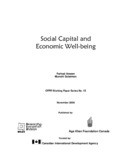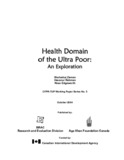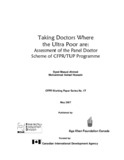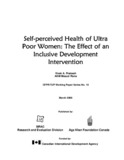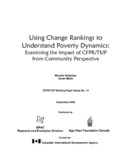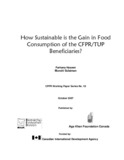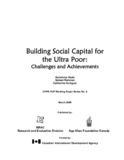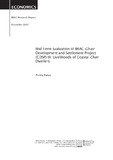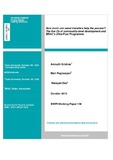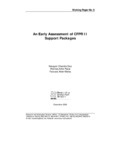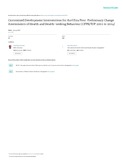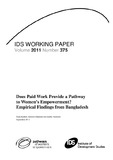Working Papers (Brac Institute of Governance and Development): Recent submissions
Now showing items 21-40 of 129
-
Social capital and economic well-Being
(BRAC Research and Evaluation Division and Aga Khan Foundation Canada, 2006-11)Sociologists and economists increasingly consider ‘social capital’ a valuable component in the asset endowment of households, improving productivity and enhancing economic well-being. Like physical and human capital, social ... -
Health domain of the ultra poor: An exploration
(BRAC Research and Evaluation Division and Aga Khan Foundation Canada, 2004-10)There has been an increasing amount of materials surrounding health-seeking behaviour in recent years. However, a relatively small proportion of literature has focused upon health behaviours and types of health services ... -
Is the BDP ultra-poor approach working? Survey of some key issues
(BRAC Research and Evaluation Division and Aga Khan Foundation Canada, 2007-05)Though BRAC’s CFPR/TUP is the specialized program for the ultra-poor, it is observed that a good portion of its microfinance clients are also very poor and require special attention. Moreover, some of the poorer households ... -
Taking doctors where the ultra poor are: Assessment of the panel doctor
(BRAC Research and Evaluation Division and Aga Khan Foundation Canada, 2007-05)To facilitate access of ultra-poor households to qualified allopathic care, especially for moderate-to-severe and chronic morbidities, the Challenging the Frontiers of Poverty Reduction/Targeting the Ultra Poor (CFPR/TUP) ... -
Self-perceived health of ultra poor women: The effect of an inclusive development intervention
(BRAC Research and Evaluation Division and Aga Khan Foundation Canada, 2006-03)In 2002, BRAC launched a targeted and comprehensive development program called Challenging the Frontiers of Poverty Reduction: Targeting the Ultra Poor (CFPR/TUP) aimed at the poorest of the poor, who have often been ... -
Impact assessment of CFPR/TUP: A descriptive analysis based on 2002-2005 panel data
(BRAC Research and Evaluation Division and Aga Khan Foundation Canada, 2006-07)The paper sets out to explore the achievements of civil society in the area of poverty reduction. The focus is mainly on three domains (1) Advocacy, (2) Policy Change, and (3) Service Delivery. Three case studies illustrate ... -
Targeting the Poorest in Microfinance: Poverty outreach of BDP ultra poor program
(BRAC Research and Evaluation Division and Aga Khan Foundation Canada, 2006-08)Despite the general consensus that microfinance does not reach the poorest; recent evidence suggests that nearly 15% of microfinance clients in Bangladesh are among the poorest. It is from the realization that even within ... -
Using change rankings to understand poverty dynamics: Examining the impact of CFPR/TUP from community perspective
(BRAC Research and Evaluation Division and Aga Khan Foundation Canada, 2006-09)Studies of poverty dynamics relying solely on household income-expenditure surveys can yield noisy results, overestimating transient poverty and underestimating persistence of poverty, especially among the poorest. In this ... -
How sustainable is the gain in food consumption of the CFPR/TUP beneficiaries?
(BRAC Research and Evaluation Division and Aga Khan Foundation Canada, 2007-10)Despite some remarkable improvements in nutritional status, malnutrition in Bangladesh is still highly prevalent, especially among the poorest. A number of initiatives are taking place that address the food intake of the ... -
Building social capital for the ultra poor: Challenges and achievements
(BRAC Research and Evaluation Division, 2005-03)BRAC introduced a program designed to meet the special needs of the extreme poor called Challenging the Frontier of Poverty Reduction: Targeting Ultra Poor (TUP) program in 2002. The program consists of economic and health ... -
Mid-Term evaluation of BRAC-Char Development and Settlement Project (CDSP)-III: Livelihoods of coastal char dwellers
(BRAC Research and Evaluation Division, 2007-12)This study was undertaken to explore the socioeconomic status of coastal char (polder) dwellers as a benchmark estimate for the BRAC-CDSP-III (Char Development and Settlement Project). A survey was carried out on 795 ... -
Social protection package for the retrenched workers of state-owned enterprises: A quick assessment
(BRAC Research and Evaluation Division, 2010-05)BRAC designed and implemented a project namely Kallyan, aiming to improve the quality of life of the retrenched workers of state-owned enterprises of Bangladesh. This study aimed to map the project’s cumulative achievements ... -
Addressing extreme poverty in a sustainable manner: Evidence from CFPR program
(BRAC Research and Evaluation Division, 2010-06)BRAC initiated an innovative program known as Challenging the Frontiers of Poverty Reduction (CFPR) in 2002 to address the extreme poverty in Bangladesh. Impact assessment studies on the first phase of CFPR (2002-06) have ... -
How much can asset transfers help the poorest? The Five Cs of community-level development and BRAC’s ultra-poor program
(Brooks World Poverty Institute, 2010-10)We develop a framework for assessing community-level development programs, building upon five related elements that are centrally important: confidence, cohesion, capacity, connections and cash (the five ‘Cs’). We use this ... -
Crafting a graduation pathway for the ultra-poor: Lessons and evidence from a BRAC program
(BRAC Research and Evaluation Division, 2008-03)The ultra poor are caught in a below-subsistence trap from which it is difficult for them to break free using available resources and mechanisms. Time is not an ally for the ultra poor, as things generally do not get ... -
Exclusion and poverty: An analytical approach for understanding exclusion and assessing programmes targeting the very poor in Bangladesh
(BRAC Research and Evaluation Division, 2008-04)Exclusion is a term that comes up often in association with poverty, social welfare and social injustice. Development interventions are designed with some notion of benefiting or including the excluded. This paper analyses ... -
Providing microfinance and social space to empower adolescent girls: An evaluation of BRAC’s ELA centres
(BRAC Research and Evaluation Division, 2008-07)Lately there has been a surge in the variety of approaches to assist the adolescents, specially the girls, in building up their lives and livelihoods. With financial assistance from Nike Foundation, BRAC started combining ... -
An early assessment of CFPR II support packages
(BRAC Research and Evaluation Division, 2009-12)Based on the programmatic lessons and research knowledge accumulated from CFPR phase I, CFPR phase II was designed to expand its outreach while incorporating greater diversity in support packages. The support packages of ... -
Customized development interventions for the ultra poor: Preliminary change assessments of health and health-seeking behaviour (CFPR/TUP 2002 to 2004)
(BRAC Research and Evaluation Division and Aga Khan Foundation Canada, 2005-06)The paper sets out to explore the achievements of civil society in the area of poverty reduction. The focus is mainly on three domains (1) Advocacy; (2) Policy Change, and (3) Service Delivery. Three case studies illustrate ... -
Does paid work provide a pathway to women’s empowerment? Empirical findings from Bangladesh
(Institute of Development Studies, 2011-09)The debate about the relationship between paid work and women’s position within the family and society is a long-standing one. Some argue that women’s integration into the market is the key to their empowerment while others ...

